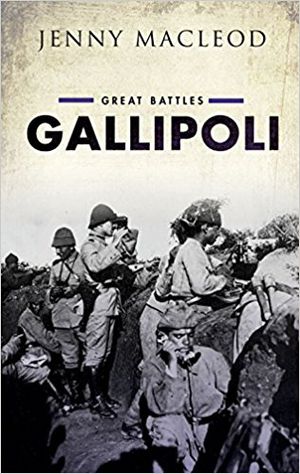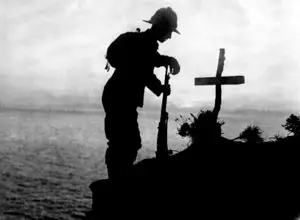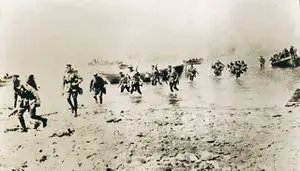Gallipoli by Jenny MacLeod - Book Review

Jenny Macleod, Gallipoli (New York: Oxford University Press, 2015).
One hundred three years have passed since the Battle of Gallipoli took place during World War I. The multi-national attack initiated by the Allies was successfully thwarted by the multi-ethnic army of the Ottoman Empire. In Gallipoli, historian Jenny Macleod discussed why the Allied plan failed, and of equal importance, how the Ottoman Army withstood the assault and emerged victorious. Although new evidence has not been unearthed, Macleod takes advantage of digitization in accessing sources and presents an insightful look into the Ottoman military. Further, this text intentionally forgoes referring to Ottoman soldiers as “Turks,” and celebrates the ethnic and religious diversity of the Ottoman military forces. Finally, going beyond the battle, the author focuses heavily on the national and cultural consequences of the battle in the aftermath of the Great War.
On March 18, 1915 the first Allied naval bombardment of Gallipoli from the Dardanelle Straits occurred. The initial idea of this attack was launched even before the Ottoman Empire entered the War on the side of the Central Powers on October 29, 1914. Russia’s Grand Duke Nicholas urged his allied partners to instigate an attack on the Ottoman Empire as their army was attacking Russian soldiers in the Caucuses Mountains. British politicians engaged in internal fighting over whether they would launch a land or naval invasion. Eventually, a combined force was decided upon and on April 25, 1915 the Mediterranean Expeditionary Forces (MEF) launched amphibious landings. Due to the terrain, fortifications, supply routes, and preparation time afforded the Ottoman Empire, the Allied operation was doomed to fail. By morning on December 20, 1915 Anzac beach had been abandoned and the same was true of Cape Helles by January 9 of the following year.
No new information regarding the actions and events of the battle are presented by Macleod, however; a more balanced narrative and a greater appreciation of the Ottoman soldiers is the result of objective history. Since its conclusion, the Battle of Gallipoli became legendary in the nations who participated, thus memory rather than fact has played a significant role in the battle’s history. Gallipoli reminds the reader that history must be constructed from solely factual and verifiable information. This is not only evident in the detailed description of the battle, it is reinforced in the second section of the book wherein the remembrance of the battle by participating nations is discussed at length.
At the time of the First World War, imperialism and colonial rule were vastly prevalent around the globe. Great Britain, especially, was a powerful and dominant empire. Australia and New Zealand were part of that empire and the soldiers from those lands entered and died at Gallipoli as a result of Britain’s declaration of war on their behalf. The aftermath of Gallipoli alone, not the War as a whole, provided the soon-to-be independent territories with their own sense of national identity. Anzac Day became a type of civil religious holiday in Australia (and to a lesser extent New Zealand) as early as 1916; first as a day to celebrate and mourn the dead. The meaning of the day changed over time and has overtones concerning feminism and pacifism. In 1915, all of Ireland fell under the British Empire. Citizens in southern Ireland, who were fighting for independence from the crown, saw no reason to celebrate the death of their sons. Sons and daughters of Erin viewed the War as a solely British endeavor and were angered over Irish blood being spilled for the sake of England.
The Ottomans, conversely to the Irish, were the victors of Gallipoli and had great reason to celebrate. On October 29, 1923, Turkey officially became an independent republic and ended more than six hundred years of Ottoman rule. Although the Ottoman Army consisted of various ethnic groups, the majority of soldiers were Turks. The military leader Mustafa Kemal Pasha, became the republic’s first leader. He was considered a hero of Gallipoli thereby strengthening the resolve of Turkish veterans and citizens to celebrate the victory at Gallipoli. As the Turks were on the losing side of the War, there was not much else to celebrate for veterans of the Central Powers in 1923. The remembrance of victory during a horrific war while at the same time rejoicing over independence provided a sense of national pride and cohesion in Turkey.
Gallipoli is a detailed account of the nations involved in that battle. The book does, however; focus more on the aftermath in the participating nations. Macleod convincingly supports her argument that due to logistics, training, and politics the Allied plan could do nothing but fail. Additionally, she conveys the respect the enemy soldiers held for each other; respect that began as hatred. No words are wasted in this balanced account of the battle and great emphasis is placed on the ensuing cultural significance. This text does what it sets out to do; offer a “military narrative of the Gallipoli campaign and its memory during the subsequent century.” Gallipoli, with its excellent bibliography and notes, is well-suited as a supplement to World War I military textbooks. Additionally, it can be used as a cultural reference for the study of post-colonial nations, and as a tool for students of history to understand the great importance of distinguishing between memory and fact.
Related Articles
- How did Mussolini Rise to Power as the Dictator of Italy
- Why did the United States refuse to join the League of Nations after World War I
- Why did the United States declare war on Germany during World War I in 1917
- What was Blitzkrieg and Who Created it
- How did Hitler become the Dictator and Fuhrer of Germany
- The Treaty of Versailles: A Concise History by Michael S. Neiberg - Book Review
- Good-Bye to All That by Robert Graves - Book Review
- Why did the Weimar Republic Collapse
- Who helped Lawrence of Arabia shape the Arab Revolt
- What Were the Causes of Germany's Hyperinflation of 1921-1923
- Why did the German Spring Offensive of 1918 fail

